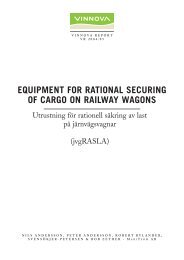Download - Autosim Autosim
Download - Autosim Autosim
Download - Autosim Autosim
Create successful ePaper yourself
Turn your PDF publications into a flip-book with our unique Google optimized e-Paper software.
CURRENT & FUTURE TECHNOLOGIES IN AUTOMOTIVE ENGINEERING SIMULATION<br />
Further refinement of the subject was carried out using a set of matrices<br />
indicating the importance of key topics regarding the materials of interest to<br />
automotive engineers (mild to ultra high strength steels, non-ferrous metals,<br />
plastics, composites, foams, and elastomerics). This was further refined by<br />
considering four different load cases typically addressed in automotive<br />
design (static, transient short term, transient long term, and cyclic).<br />
Analysis of the matrices confirmed that many topics still need more<br />
development in order to move automotive CAE forward. The following<br />
topics were distilled from the results:<br />
• New ultra High Strength Steels require new constitutive models<br />
• Strain Rate Sensitivity for all materials (short duration transient<br />
loading)<br />
• Composites (all load cases) for material properties, modes, failure<br />
or damage, connections, and even the effects of forming<br />
• Failure/Fracture/Damage involving most materials across all load<br />
cases; understanding the differences and how to best model them<br />
in CAE<br />
• Effects of Forming for all materials for short duration loading and<br />
non-metals for other cases; effect of assembly also highlighted,<br />
particularly for metals.<br />
• Choice of Constitutive Models for non-metals—complexity vs.<br />
ease of use<br />
• Modelling Connections for all materials and most load cases<br />
Several of the presentations to the Technical Workshops have explored one<br />
or more of these topics; please see the AUTOSIM web site for details (Ref.<br />
[8]).<br />
4.3.3 Best Practice—Is it already in use?<br />
To supplement the circulated questionnaire and matrices, an analysis of the<br />
automotive development process was carried out. The result was a more<br />
detailed view of the material models used in specific areas of virtual car<br />
development and the identification of important issues mentioned by CAE<br />
engineers in their daily work. These issues were assessed by comparison<br />
with other simulation topics, such as model creation, quality of geometrical<br />
data, etc. Clearly this analysis is not complete and might vary for each car<br />
manufacturer. However, discussions at the Technical Workshops suggest<br />
that the findings are valid for most OEMs.<br />
22 |<br />
SIXTH FRAMEWORK PROGRAMME PRIORITY [6.2] [SUSTAINABLE SURFACE TRANSPORT]<br />
012497 AUTOSIM
















